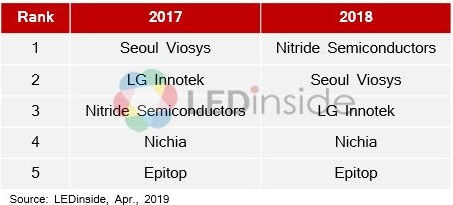- News
29 April 2019
Anti-bacterial UV-C LED applications driving stable growth in UV-LED market
UV LED makers did not see explosive growth in revenue as expected for 2018 due to the global recession yet they did see a steady increase, according to the report ‘2019 Deep UV LED Application Market- Sterilization, Purification and Water Treatment Markets’ by LEDinside (a division of TrendForce). UV-LED revenues are expected to ride UV-C LED market demand and are rising at a compound annual growth rate (CAGR) of 29% from $223m in 2017 to US$991m in 2023.

Graphic: UV LED revenue in 2017 and 2023 (forecast).
According to analyses by research manager Joanne Wu, as Japanese and Korean manufacturers move eagerly into the UV LED market the global supplier rankings by revenue have been reshuffled in 2018, to Nitride Semiconductors, Seoul Viosys, LG Innotek, Nichia and Epitop (i.e. with Nitride Semiconductors rising from third in 2017, overtaking Seoul Viosys and LG Innotek).

Graphic: UV-LED supplier rankings for 2017 and 2018.
A glance at demand shows that UV-C LED applications continue to be the powerhouse for market growth. LEDinside forecasts that 2019 will see vigorous UV-C LED product development by many LED makers, including Nichia, OSRAM Opto Semiconductors, UVphototonics, Violumas and others, injecting new momentum into the market.
Existing UV-C external quantum efficiencies (EQEs) average 1-3%, while industry leader LG Innotek's EQE may reach up to 4.33%. Other suppliers such as Stanley, DOWA, Nitride Semiconductors and Seoul Viosys also continue to raise product efficiencies.
Nichia released its 280nm-wavelength UV-C LED products in April, while OSRAM is poised to release UV-C LED products in second-half 2019. Taiwanese suppliers such as Epistar and Lextar have launched 275-285nm UV-C LED products, whereas Bioraytron has launched a 265nm UV-C LED. Other companies such as Everlight, Lite-On and UVT are also making their way into UV-C LED markets.
Suppliers active in UV-C LED product development; market to split into two
There are three main motivators for UV-C LED application market growth: surface/air sterilization, static water sterilization, and flowing water sterilization.
Static water and surface disinfection (for air purification and appliances etc) have more relaxed exposure time requirements and are used in a wide range of applications. They also gave rise to many emerging markets, including baby products, everyday cell phones, escalators, household products (such as toothbrushes), toiletries, cabinets, sport bottles and thermos flasks.
Flowing water sterilization is more demanding due to its fast-acting nature, and naturally requires a higher power level. The market for household water treatment includes applications such as water dispensers, hot and cold kitchen water, whole house water filters and baby products (baby formula makers) etc.
Commercially and industrially speaking, the global water treatment market is about US$20bn, becoming the UV-C LED target market with the most potential for development. The three main methods used in water sterilization are gravity-based purification, RO (reverse osmosis) purification and UV purification. RO purification is a widely used technology, yet it should still be used in conjunction with UV purification to rid water of bacteria and viruses and lower overall TOC (total organic carbon) concentration.
To meet the demands of the water treatment market, Japanese and Korean manufacturers are actively developing high-power UV-C LEDs and moving into the market for flowing water modules. LEDinside predicts that the UV-C LED market will diverge into two: a general consumer market and an advanced commercial/industrial market.


